Importance of Project Planning Verification and Validation 2022
VerifiedAdded on 2022/10/04
|13
|2901
|16
AI Summary
Contribute Materials
Your contribution can guide someone’s learning journey. Share your
documents today.

Running head: IMPORTANCE OF PROJECT PLANNING, VERIFICATION AND VALIDATION
Importance of Project Planning, Verification and Validation
Name of the Student
Name of the University
Author note
Importance of Project Planning, Verification and Validation
Name of the Student
Name of the University
Author note
Secure Best Marks with AI Grader
Need help grading? Try our AI Grader for instant feedback on your assignments.
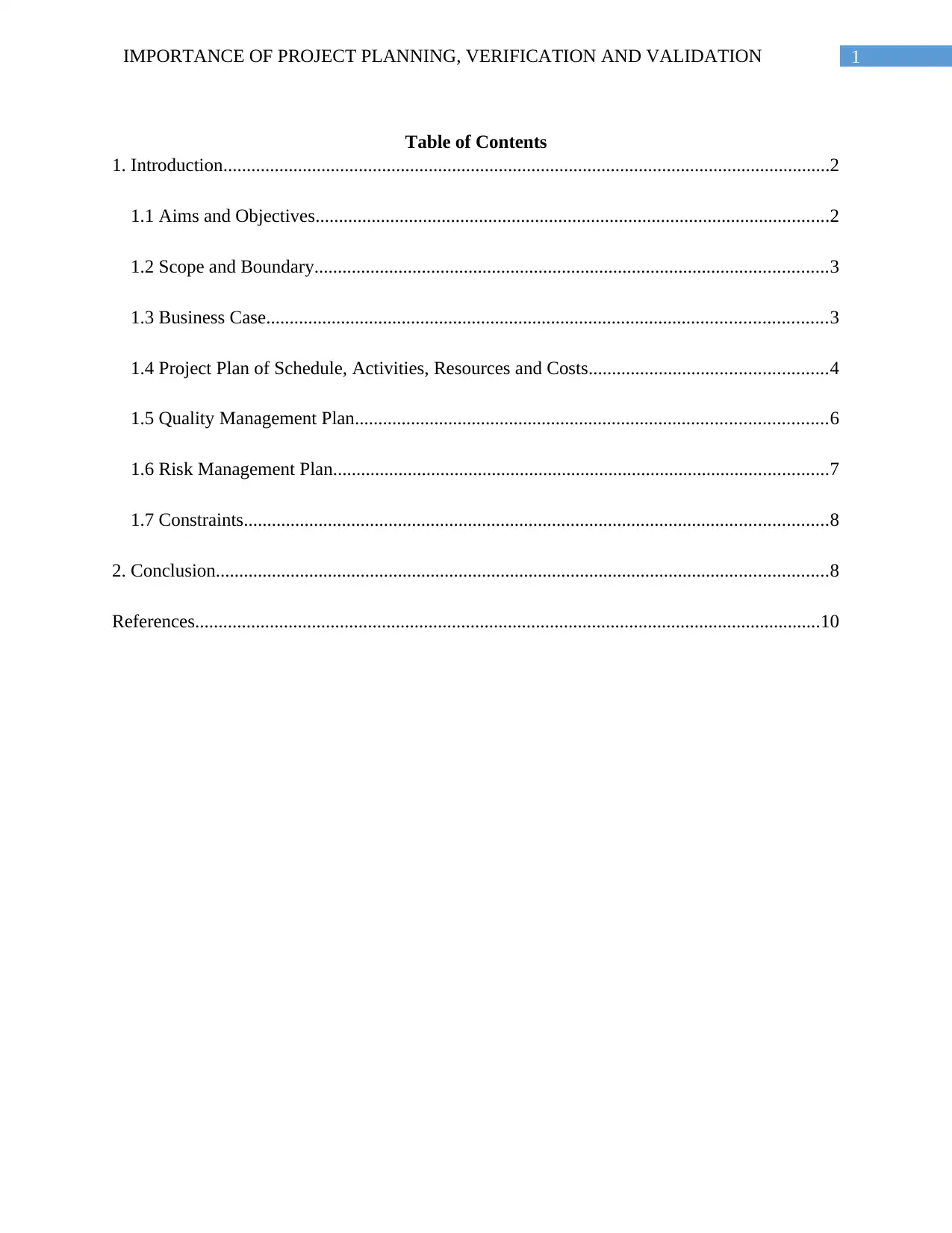
1IMPORTANCE OF PROJECT PLANNING, VERIFICATION AND VALIDATION
Table of Contents
1. Introduction..................................................................................................................................2
1.1 Aims and Objectives..............................................................................................................2
1.2 Scope and Boundary..............................................................................................................3
1.3 Business Case........................................................................................................................3
1.4 Project Plan of Schedule, Activities, Resources and Costs...................................................4
1.5 Quality Management Plan.....................................................................................................6
1.6 Risk Management Plan..........................................................................................................7
1.7 Constraints.............................................................................................................................8
2. Conclusion...................................................................................................................................8
References......................................................................................................................................10
Table of Contents
1. Introduction..................................................................................................................................2
1.1 Aims and Objectives..............................................................................................................2
1.2 Scope and Boundary..............................................................................................................3
1.3 Business Case........................................................................................................................3
1.4 Project Plan of Schedule, Activities, Resources and Costs...................................................4
1.5 Quality Management Plan.....................................................................................................6
1.6 Risk Management Plan..........................................................................................................7
1.7 Constraints.............................................................................................................................8
2. Conclusion...................................................................................................................................8
References......................................................................................................................................10
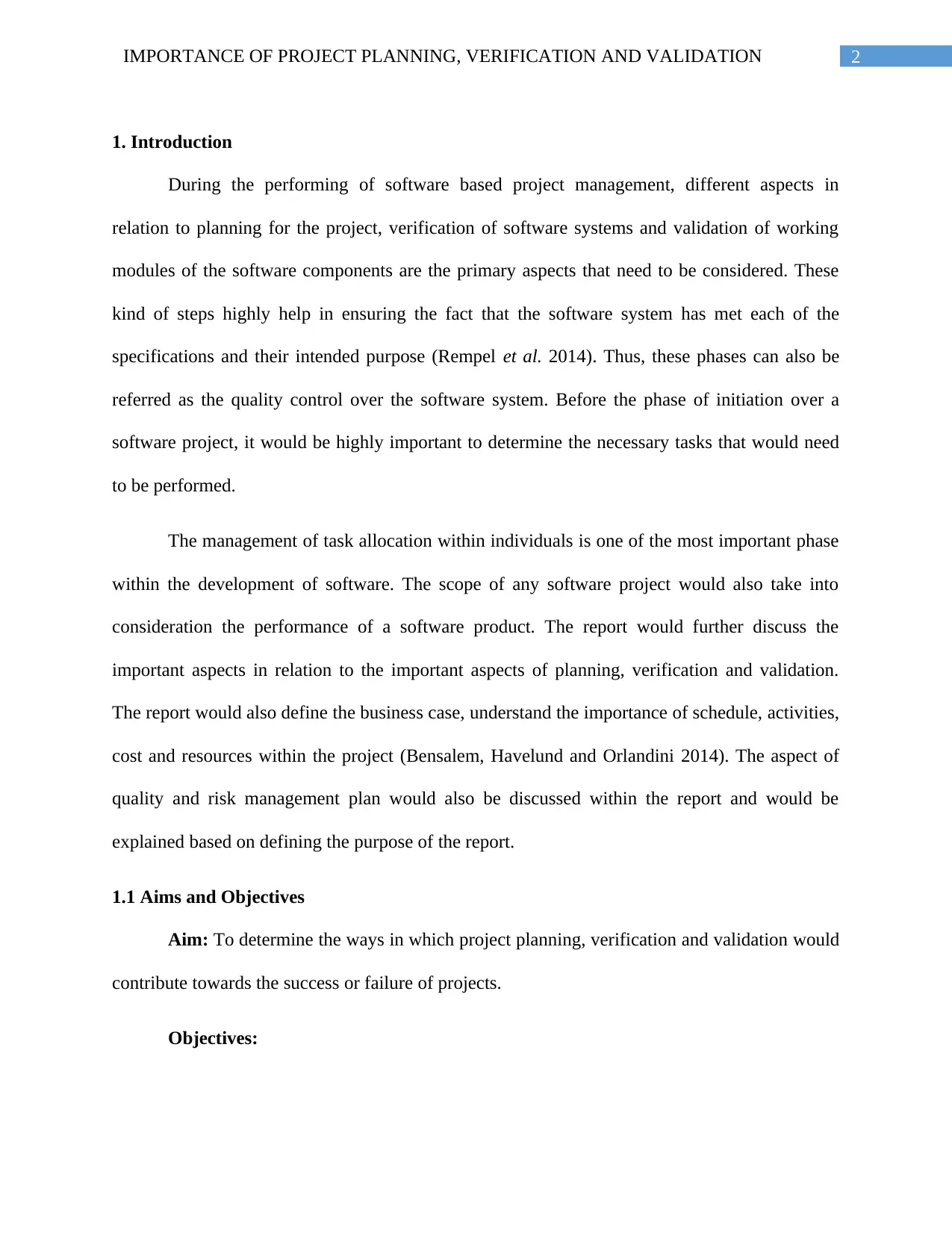
2IMPORTANCE OF PROJECT PLANNING, VERIFICATION AND VALIDATION
1. Introduction
During the performing of software based project management, different aspects in
relation to planning for the project, verification of software systems and validation of working
modules of the software components are the primary aspects that need to be considered. These
kind of steps highly help in ensuring the fact that the software system has met each of the
specifications and their intended purpose (Rempel et al. 2014). Thus, these phases can also be
referred as the quality control over the software system. Before the phase of initiation over a
software project, it would be highly important to determine the necessary tasks that would need
to be performed.
The management of task allocation within individuals is one of the most important phase
within the development of software. The scope of any software project would also take into
consideration the performance of a software product. The report would further discuss the
important aspects in relation to the important aspects of planning, verification and validation.
The report would also define the business case, understand the importance of schedule, activities,
cost and resources within the project (Bensalem, Havelund and Orlandini 2014). The aspect of
quality and risk management plan would also be discussed within the report and would be
explained based on defining the purpose of the report.
1.1 Aims and Objectives
Aim: To determine the ways in which project planning, verification and validation would
contribute towards the success or failure of projects.
Objectives:
1. Introduction
During the performing of software based project management, different aspects in
relation to planning for the project, verification of software systems and validation of working
modules of the software components are the primary aspects that need to be considered. These
kind of steps highly help in ensuring the fact that the software system has met each of the
specifications and their intended purpose (Rempel et al. 2014). Thus, these phases can also be
referred as the quality control over the software system. Before the phase of initiation over a
software project, it would be highly important to determine the necessary tasks that would need
to be performed.
The management of task allocation within individuals is one of the most important phase
within the development of software. The scope of any software project would also take into
consideration the performance of a software product. The report would further discuss the
important aspects in relation to the important aspects of planning, verification and validation.
The report would also define the business case, understand the importance of schedule, activities,
cost and resources within the project (Bensalem, Havelund and Orlandini 2014). The aspect of
quality and risk management plan would also be discussed within the report and would be
explained based on defining the purpose of the report.
1.1 Aims and Objectives
Aim: To determine the ways in which project planning, verification and validation would
contribute towards the success or failure of projects.
Objectives:
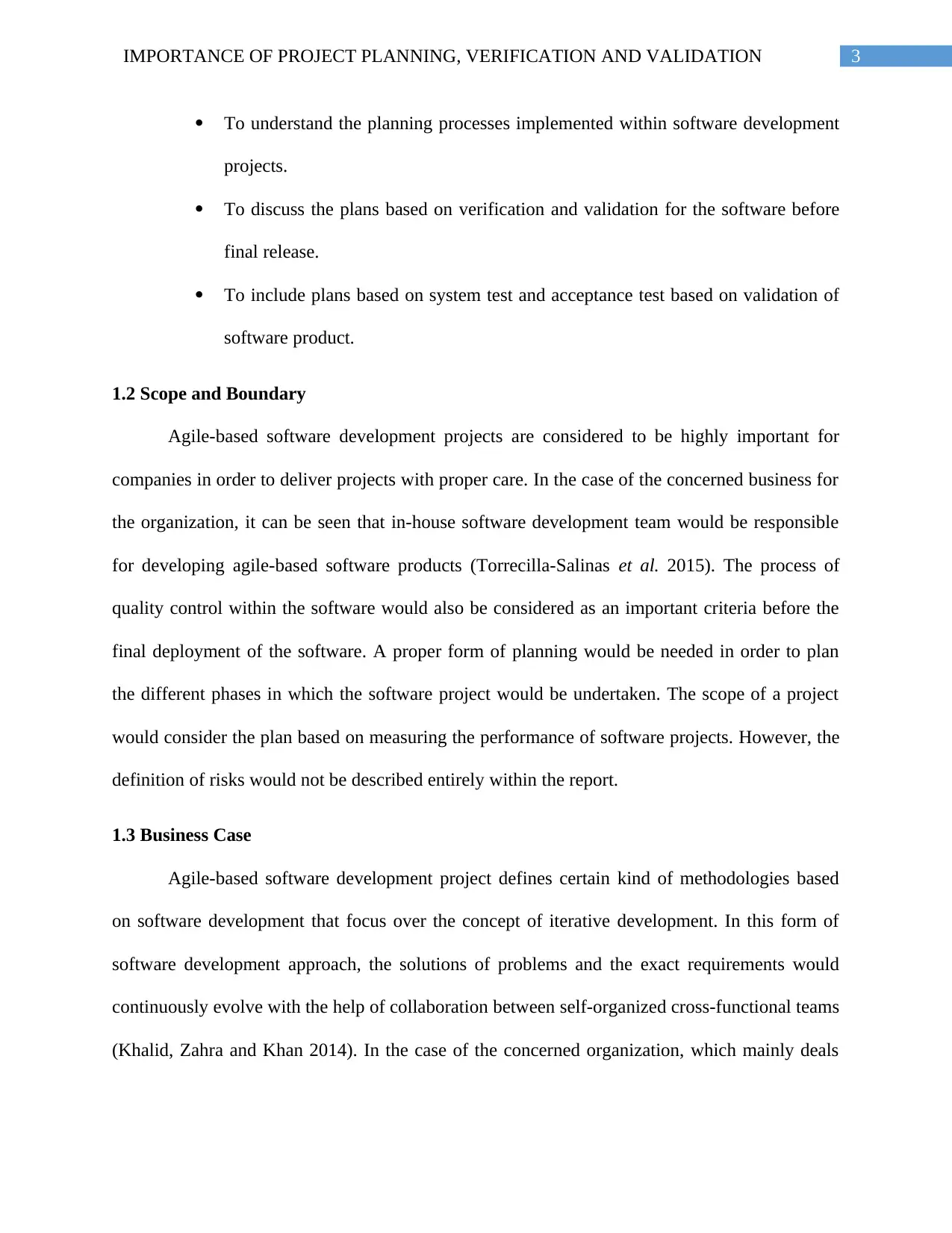
3IMPORTANCE OF PROJECT PLANNING, VERIFICATION AND VALIDATION
To understand the planning processes implemented within software development
projects.
To discuss the plans based on verification and validation for the software before
final release.
To include plans based on system test and acceptance test based on validation of
software product.
1.2 Scope and Boundary
Agile-based software development projects are considered to be highly important for
companies in order to deliver projects with proper care. In the case of the concerned business for
the organization, it can be seen that in-house software development team would be responsible
for developing agile-based software products (Torrecilla-Salinas et al. 2015). The process of
quality control within the software would also be considered as an important criteria before the
final deployment of the software. A proper form of planning would be needed in order to plan
the different phases in which the software project would be undertaken. The scope of a project
would consider the plan based on measuring the performance of software projects. However, the
definition of risks would not be described entirely within the report.
1.3 Business Case
Agile-based software development project defines certain kind of methodologies based
on software development that focus over the concept of iterative development. In this form of
software development approach, the solutions of problems and the exact requirements would
continuously evolve with the help of collaboration between self-organized cross-functional teams
(Khalid, Zahra and Khan 2014). In the case of the concerned organization, which mainly deals
To understand the planning processes implemented within software development
projects.
To discuss the plans based on verification and validation for the software before
final release.
To include plans based on system test and acceptance test based on validation of
software product.
1.2 Scope and Boundary
Agile-based software development projects are considered to be highly important for
companies in order to deliver projects with proper care. In the case of the concerned business for
the organization, it can be seen that in-house software development team would be responsible
for developing agile-based software products (Torrecilla-Salinas et al. 2015). The process of
quality control within the software would also be considered as an important criteria before the
final deployment of the software. A proper form of planning would be needed in order to plan
the different phases in which the software project would be undertaken. The scope of a project
would consider the plan based on measuring the performance of software projects. However, the
definition of risks would not be described entirely within the report.
1.3 Business Case
Agile-based software development project defines certain kind of methodologies based
on software development that focus over the concept of iterative development. In this form of
software development approach, the solutions of problems and the exact requirements would
continuously evolve with the help of collaboration between self-organized cross-functional teams
(Khalid, Zahra and Khan 2014). In the case of the concerned organization, which mainly deals
Secure Best Marks with AI Grader
Need help grading? Try our AI Grader for instant feedback on your assignments.
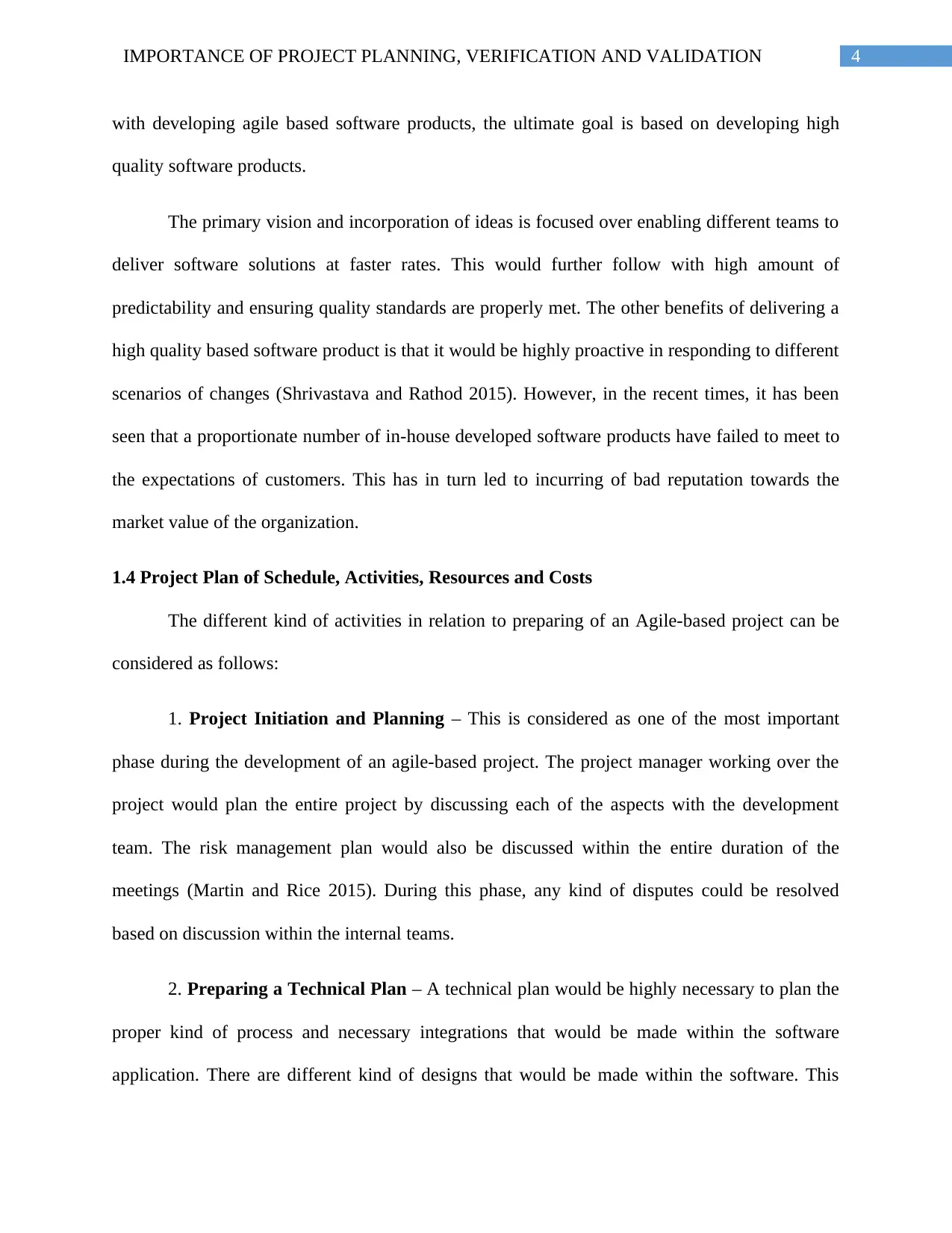
4IMPORTANCE OF PROJECT PLANNING, VERIFICATION AND VALIDATION
with developing agile based software products, the ultimate goal is based on developing high
quality software products.
The primary vision and incorporation of ideas is focused over enabling different teams to
deliver software solutions at faster rates. This would further follow with high amount of
predictability and ensuring quality standards are properly met. The other benefits of delivering a
high quality based software product is that it would be highly proactive in responding to different
scenarios of changes (Shrivastava and Rathod 2015). However, in the recent times, it has been
seen that a proportionate number of in-house developed software products have failed to meet to
the expectations of customers. This has in turn led to incurring of bad reputation towards the
market value of the organization.
1.4 Project Plan of Schedule, Activities, Resources and Costs
The different kind of activities in relation to preparing of an Agile-based project can be
considered as follows:
1. Project Initiation and Planning – This is considered as one of the most important
phase during the development of an agile-based project. The project manager working over the
project would plan the entire project by discussing each of the aspects with the development
team. The risk management plan would also be discussed within the entire duration of the
meetings (Martin and Rice 2015). During this phase, any kind of disputes could be resolved
based on discussion within the internal teams.
2. Preparing a Technical Plan – A technical plan would be highly necessary to plan the
proper kind of process and necessary integrations that would be made within the software
application. There are different kind of designs that would be made within the software. This
with developing agile based software products, the ultimate goal is based on developing high
quality software products.
The primary vision and incorporation of ideas is focused over enabling different teams to
deliver software solutions at faster rates. This would further follow with high amount of
predictability and ensuring quality standards are properly met. The other benefits of delivering a
high quality based software product is that it would be highly proactive in responding to different
scenarios of changes (Shrivastava and Rathod 2015). However, in the recent times, it has been
seen that a proportionate number of in-house developed software products have failed to meet to
the expectations of customers. This has in turn led to incurring of bad reputation towards the
market value of the organization.
1.4 Project Plan of Schedule, Activities, Resources and Costs
The different kind of activities in relation to preparing of an Agile-based project can be
considered as follows:
1. Project Initiation and Planning – This is considered as one of the most important
phase during the development of an agile-based project. The project manager working over the
project would plan the entire project by discussing each of the aspects with the development
team. The risk management plan would also be discussed within the entire duration of the
meetings (Martin and Rice 2015). During this phase, any kind of disputes could be resolved
based on discussion within the internal teams.
2. Preparing a Technical Plan – A technical plan would be highly necessary to plan the
proper kind of process and necessary integrations that would be made within the software
application. There are different kind of designs that would be made within the software. This
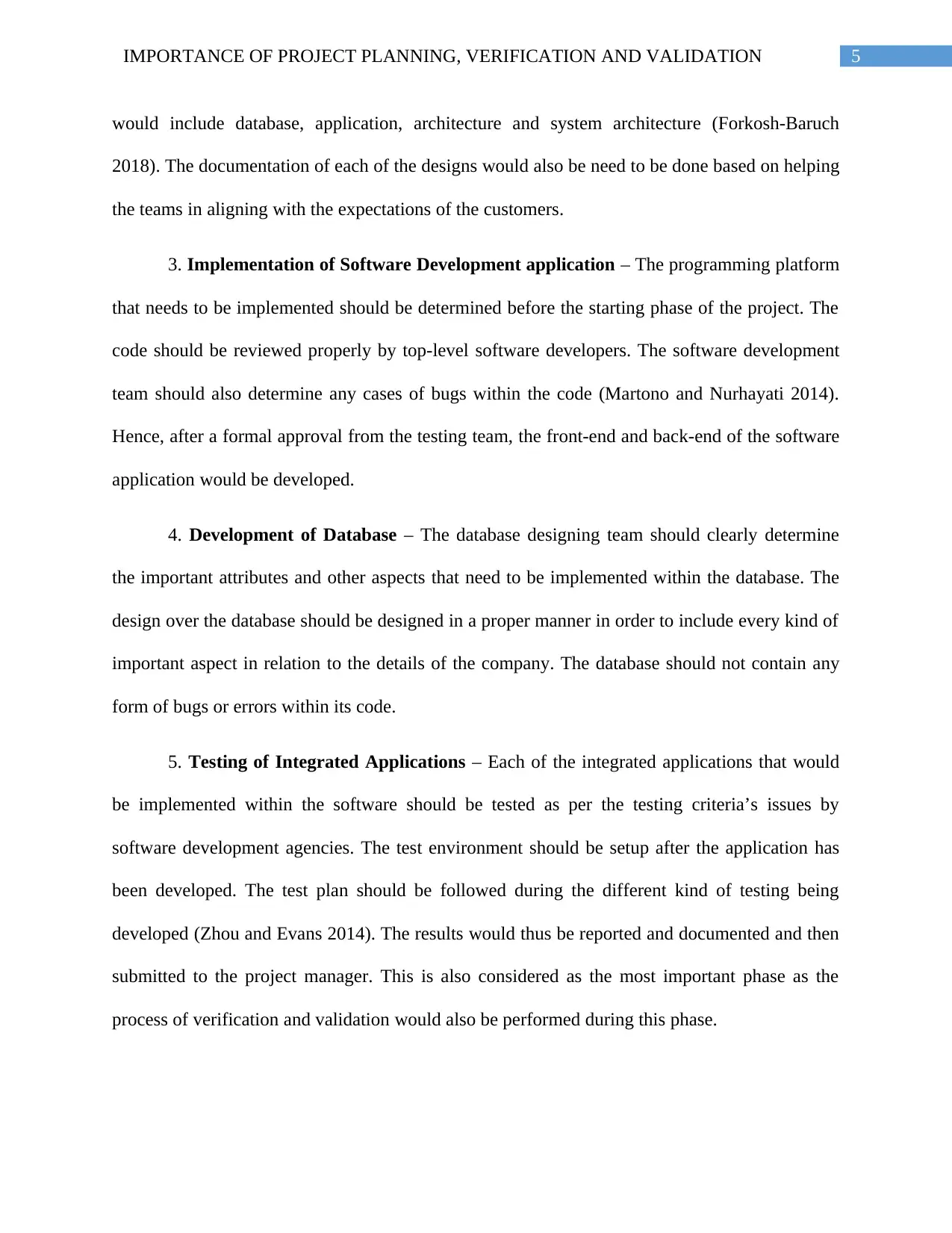
5IMPORTANCE OF PROJECT PLANNING, VERIFICATION AND VALIDATION
would include database, application, architecture and system architecture (Forkosh-Baruch
2018). The documentation of each of the designs would also be need to be done based on helping
the teams in aligning with the expectations of the customers.
3. Implementation of Software Development application – The programming platform
that needs to be implemented should be determined before the starting phase of the project. The
code should be reviewed properly by top-level software developers. The software development
team should also determine any cases of bugs within the code (Martono and Nurhayati 2014).
Hence, after a formal approval from the testing team, the front-end and back-end of the software
application would be developed.
4. Development of Database – The database designing team should clearly determine
the important attributes and other aspects that need to be implemented within the database. The
design over the database should be designed in a proper manner in order to include every kind of
important aspect in relation to the details of the company. The database should not contain any
form of bugs or errors within its code.
5. Testing of Integrated Applications – Each of the integrated applications that would
be implemented within the software should be tested as per the testing criteria’s issues by
software development agencies. The test environment should be setup after the application has
been developed. The test plan should be followed during the different kind of testing being
developed (Zhou and Evans 2014). The results would thus be reported and documented and then
submitted to the project manager. This is also considered as the most important phase as the
process of verification and validation would also be performed during this phase.
would include database, application, architecture and system architecture (Forkosh-Baruch
2018). The documentation of each of the designs would also be need to be done based on helping
the teams in aligning with the expectations of the customers.
3. Implementation of Software Development application – The programming platform
that needs to be implemented should be determined before the starting phase of the project. The
code should be reviewed properly by top-level software developers. The software development
team should also determine any cases of bugs within the code (Martono and Nurhayati 2014).
Hence, after a formal approval from the testing team, the front-end and back-end of the software
application would be developed.
4. Development of Database – The database designing team should clearly determine
the important attributes and other aspects that need to be implemented within the database. The
design over the database should be designed in a proper manner in order to include every kind of
important aspect in relation to the details of the company. The database should not contain any
form of bugs or errors within its code.
5. Testing of Integrated Applications – Each of the integrated applications that would
be implemented within the software should be tested as per the testing criteria’s issues by
software development agencies. The test environment should be setup after the application has
been developed. The test plan should be followed during the different kind of testing being
developed (Zhou and Evans 2014). The results would thus be reported and documented and then
submitted to the project manager. This is also considered as the most important phase as the
process of verification and validation would also be performed during this phase.
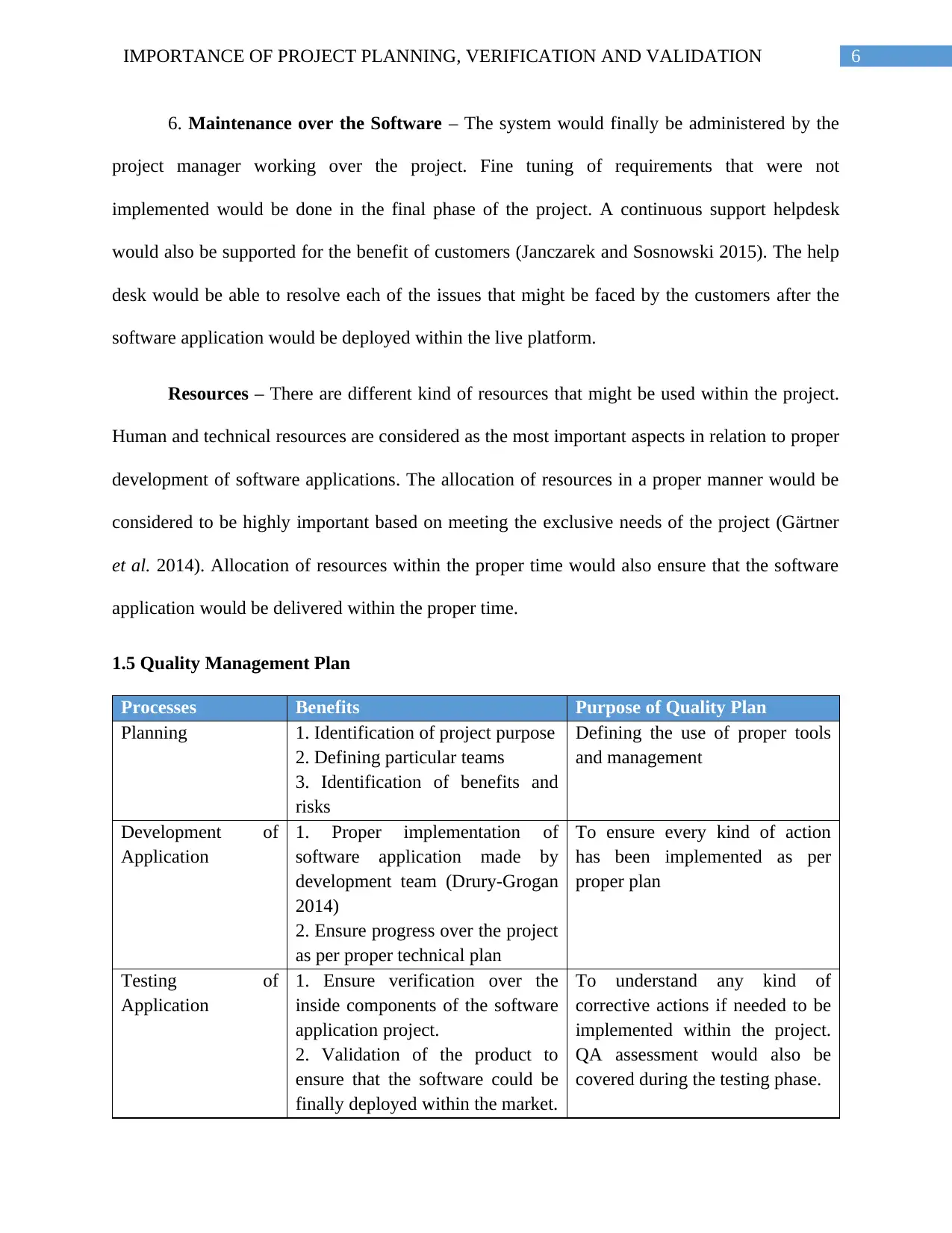
6IMPORTANCE OF PROJECT PLANNING, VERIFICATION AND VALIDATION
6. Maintenance over the Software – The system would finally be administered by the
project manager working over the project. Fine tuning of requirements that were not
implemented would be done in the final phase of the project. A continuous support helpdesk
would also be supported for the benefit of customers (Janczarek and Sosnowski 2015). The help
desk would be able to resolve each of the issues that might be faced by the customers after the
software application would be deployed within the live platform.
Resources – There are different kind of resources that might be used within the project.
Human and technical resources are considered as the most important aspects in relation to proper
development of software applications. The allocation of resources in a proper manner would be
considered to be highly important based on meeting the exclusive needs of the project (Gärtner
et al. 2014). Allocation of resources within the proper time would also ensure that the software
application would be delivered within the proper time.
1.5 Quality Management Plan
Processes Benefits Purpose of Quality Plan
Planning 1. Identification of project purpose
2. Defining particular teams
3. Identification of benefits and
risks
Defining the use of proper tools
and management
Development of
Application
1. Proper implementation of
software application made by
development team (Drury-Grogan
2014)
2. Ensure progress over the project
as per proper technical plan
To ensure every kind of action
has been implemented as per
proper plan
Testing of
Application
1. Ensure verification over the
inside components of the software
application project.
2. Validation of the product to
ensure that the software could be
finally deployed within the market.
To understand any kind of
corrective actions if needed to be
implemented within the project.
QA assessment would also be
covered during the testing phase.
6. Maintenance over the Software – The system would finally be administered by the
project manager working over the project. Fine tuning of requirements that were not
implemented would be done in the final phase of the project. A continuous support helpdesk
would also be supported for the benefit of customers (Janczarek and Sosnowski 2015). The help
desk would be able to resolve each of the issues that might be faced by the customers after the
software application would be deployed within the live platform.
Resources – There are different kind of resources that might be used within the project.
Human and technical resources are considered as the most important aspects in relation to proper
development of software applications. The allocation of resources in a proper manner would be
considered to be highly important based on meeting the exclusive needs of the project (Gärtner
et al. 2014). Allocation of resources within the proper time would also ensure that the software
application would be delivered within the proper time.
1.5 Quality Management Plan
Processes Benefits Purpose of Quality Plan
Planning 1. Identification of project purpose
2. Defining particular teams
3. Identification of benefits and
risks
Defining the use of proper tools
and management
Development of
Application
1. Proper implementation of
software application made by
development team (Drury-Grogan
2014)
2. Ensure progress over the project
as per proper technical plan
To ensure every kind of action
has been implemented as per
proper plan
Testing of
Application
1. Ensure verification over the
inside components of the software
application project.
2. Validation of the product to
ensure that the software could be
finally deployed within the market.
To understand any kind of
corrective actions if needed to be
implemented within the project.
QA assessment would also be
covered during the testing phase.
Paraphrase This Document
Need a fresh take? Get an instant paraphrase of this document with our AI Paraphraser
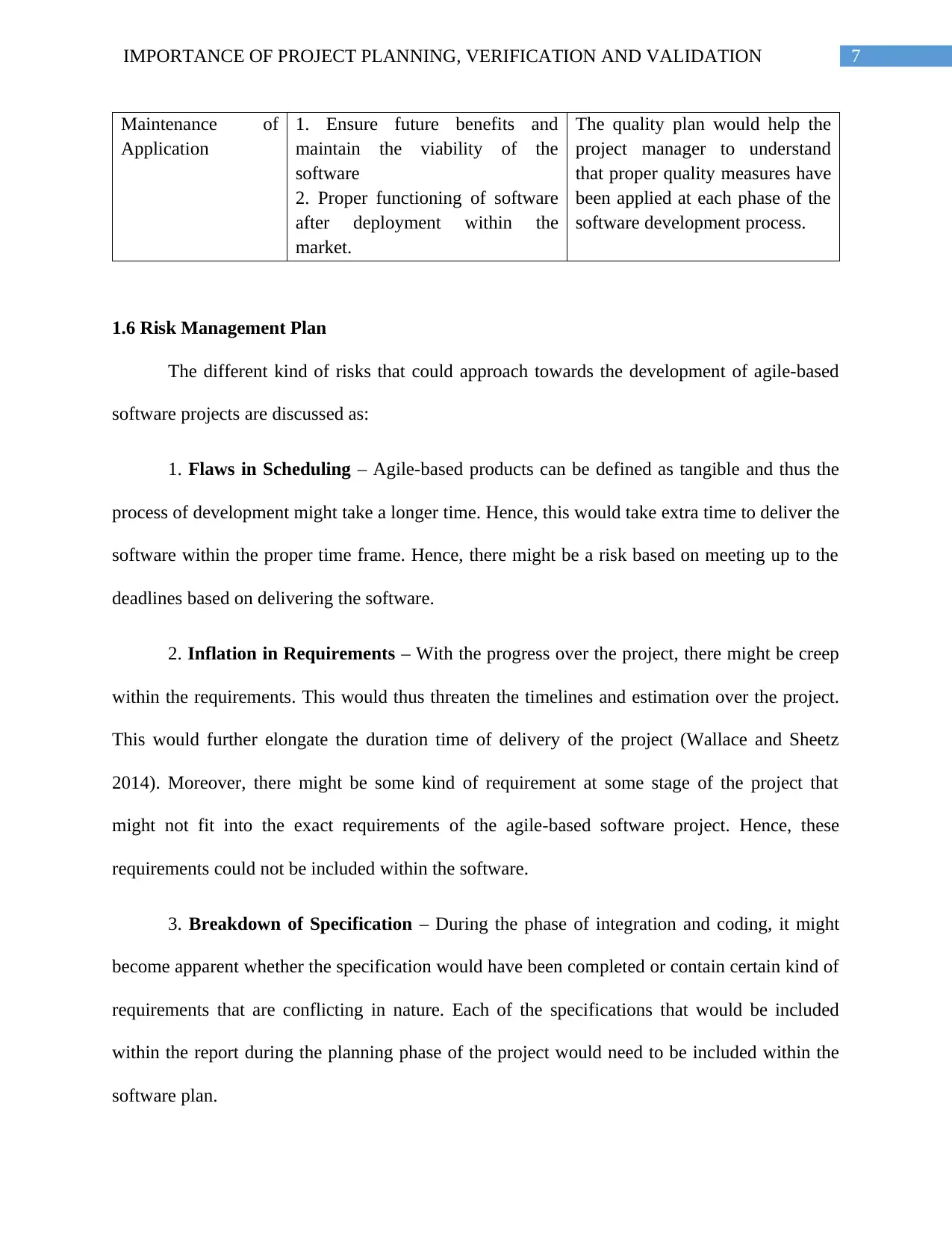
7IMPORTANCE OF PROJECT PLANNING, VERIFICATION AND VALIDATION
Maintenance of
Application
1. Ensure future benefits and
maintain the viability of the
software
2. Proper functioning of software
after deployment within the
market.
The quality plan would help the
project manager to understand
that proper quality measures have
been applied at each phase of the
software development process.
1.6 Risk Management Plan
The different kind of risks that could approach towards the development of agile-based
software projects are discussed as:
1. Flaws in Scheduling – Agile-based products can be defined as tangible and thus the
process of development might take a longer time. Hence, this would take extra time to deliver the
software within the proper time frame. Hence, there might be a risk based on meeting up to the
deadlines based on delivering the software.
2. Inflation in Requirements – With the progress over the project, there might be creep
within the requirements. This would thus threaten the timelines and estimation over the project.
This would further elongate the duration time of delivery of the project (Wallace and Sheetz
2014). Moreover, there might be some kind of requirement at some stage of the project that
might not fit into the exact requirements of the agile-based software project. Hence, these
requirements could not be included within the software.
3. Breakdown of Specification – During the phase of integration and coding, it might
become apparent whether the specification would have been completed or contain certain kind of
requirements that are conflicting in nature. Each of the specifications that would be included
within the report during the planning phase of the project would need to be included within the
software plan.
Maintenance of
Application
1. Ensure future benefits and
maintain the viability of the
software
2. Proper functioning of software
after deployment within the
market.
The quality plan would help the
project manager to understand
that proper quality measures have
been applied at each phase of the
software development process.
1.6 Risk Management Plan
The different kind of risks that could approach towards the development of agile-based
software projects are discussed as:
1. Flaws in Scheduling – Agile-based products can be defined as tangible and thus the
process of development might take a longer time. Hence, this would take extra time to deliver the
software within the proper time frame. Hence, there might be a risk based on meeting up to the
deadlines based on delivering the software.
2. Inflation in Requirements – With the progress over the project, there might be creep
within the requirements. This would thus threaten the timelines and estimation over the project.
This would further elongate the duration time of delivery of the project (Wallace and Sheetz
2014). Moreover, there might be some kind of requirement at some stage of the project that
might not fit into the exact requirements of the agile-based software project. Hence, these
requirements could not be included within the software.
3. Breakdown of Specification – During the phase of integration and coding, it might
become apparent whether the specification would have been completed or contain certain kind of
requirements that are conflicting in nature. Each of the specifications that would be included
within the report during the planning phase of the project would need to be included within the
software plan.
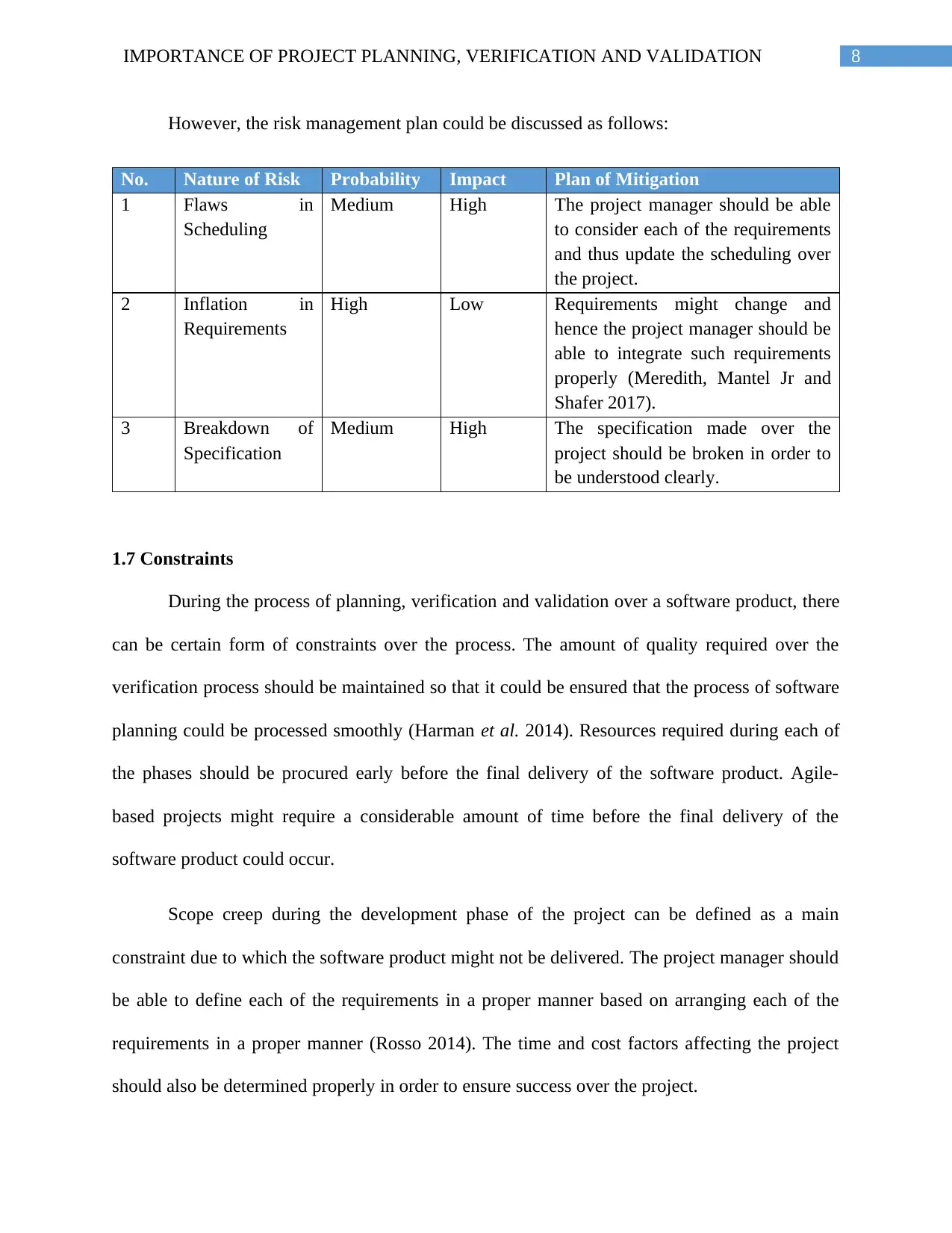
8IMPORTANCE OF PROJECT PLANNING, VERIFICATION AND VALIDATION
However, the risk management plan could be discussed as follows:
No. Nature of Risk Probability Impact Plan of Mitigation
1 Flaws in
Scheduling
Medium High The project manager should be able
to consider each of the requirements
and thus update the scheduling over
the project.
2 Inflation in
Requirements
High Low Requirements might change and
hence the project manager should be
able to integrate such requirements
properly (Meredith, Mantel Jr and
Shafer 2017).
3 Breakdown of
Specification
Medium High The specification made over the
project should be broken in order to
be understood clearly.
1.7 Constraints
During the process of planning, verification and validation over a software product, there
can be certain form of constraints over the process. The amount of quality required over the
verification process should be maintained so that it could be ensured that the process of software
planning could be processed smoothly (Harman et al. 2014). Resources required during each of
the phases should be procured early before the final delivery of the software product. Agile-
based projects might require a considerable amount of time before the final delivery of the
software product could occur.
Scope creep during the development phase of the project can be defined as a main
constraint due to which the software product might not be delivered. The project manager should
be able to define each of the requirements in a proper manner based on arranging each of the
requirements in a proper manner (Rosso 2014). The time and cost factors affecting the project
should also be determined properly in order to ensure success over the project.
However, the risk management plan could be discussed as follows:
No. Nature of Risk Probability Impact Plan of Mitigation
1 Flaws in
Scheduling
Medium High The project manager should be able
to consider each of the requirements
and thus update the scheduling over
the project.
2 Inflation in
Requirements
High Low Requirements might change and
hence the project manager should be
able to integrate such requirements
properly (Meredith, Mantel Jr and
Shafer 2017).
3 Breakdown of
Specification
Medium High The specification made over the
project should be broken in order to
be understood clearly.
1.7 Constraints
During the process of planning, verification and validation over a software product, there
can be certain form of constraints over the process. The amount of quality required over the
verification process should be maintained so that it could be ensured that the process of software
planning could be processed smoothly (Harman et al. 2014). Resources required during each of
the phases should be procured early before the final delivery of the software product. Agile-
based projects might require a considerable amount of time before the final delivery of the
software product could occur.
Scope creep during the development phase of the project can be defined as a main
constraint due to which the software product might not be delivered. The project manager should
be able to define each of the requirements in a proper manner based on arranging each of the
requirements in a proper manner (Rosso 2014). The time and cost factors affecting the project
should also be determined properly in order to ensure success over the project.
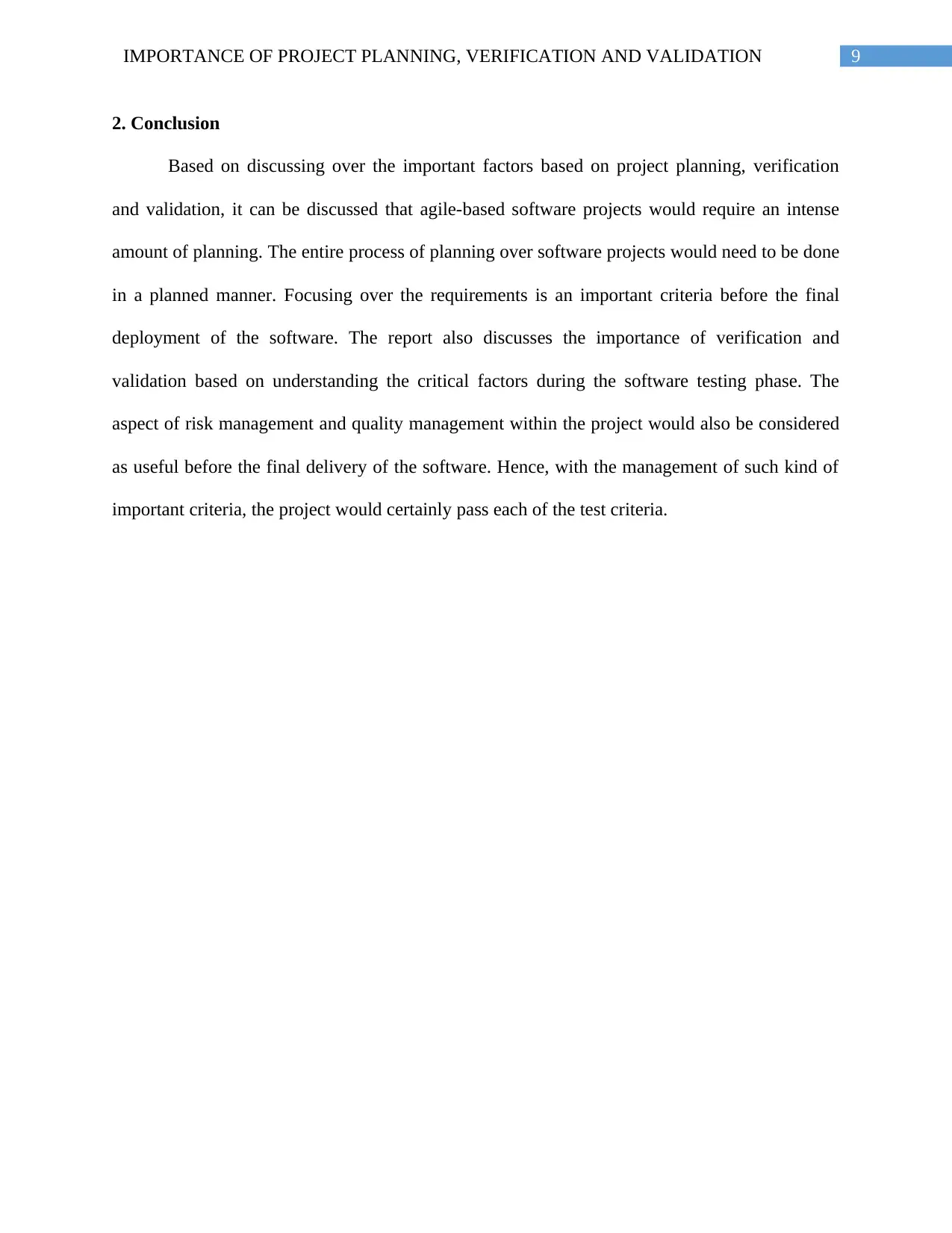
9IMPORTANCE OF PROJECT PLANNING, VERIFICATION AND VALIDATION
2. Conclusion
Based on discussing over the important factors based on project planning, verification
and validation, it can be discussed that agile-based software projects would require an intense
amount of planning. The entire process of planning over software projects would need to be done
in a planned manner. Focusing over the requirements is an important criteria before the final
deployment of the software. The report also discusses the importance of verification and
validation based on understanding the critical factors during the software testing phase. The
aspect of risk management and quality management within the project would also be considered
as useful before the final delivery of the software. Hence, with the management of such kind of
important criteria, the project would certainly pass each of the test criteria.
2. Conclusion
Based on discussing over the important factors based on project planning, verification
and validation, it can be discussed that agile-based software projects would require an intense
amount of planning. The entire process of planning over software projects would need to be done
in a planned manner. Focusing over the requirements is an important criteria before the final
deployment of the software. The report also discusses the importance of verification and
validation based on understanding the critical factors during the software testing phase. The
aspect of risk management and quality management within the project would also be considered
as useful before the final delivery of the software. Hence, with the management of such kind of
important criteria, the project would certainly pass each of the test criteria.
Secure Best Marks with AI Grader
Need help grading? Try our AI Grader for instant feedback on your assignments.
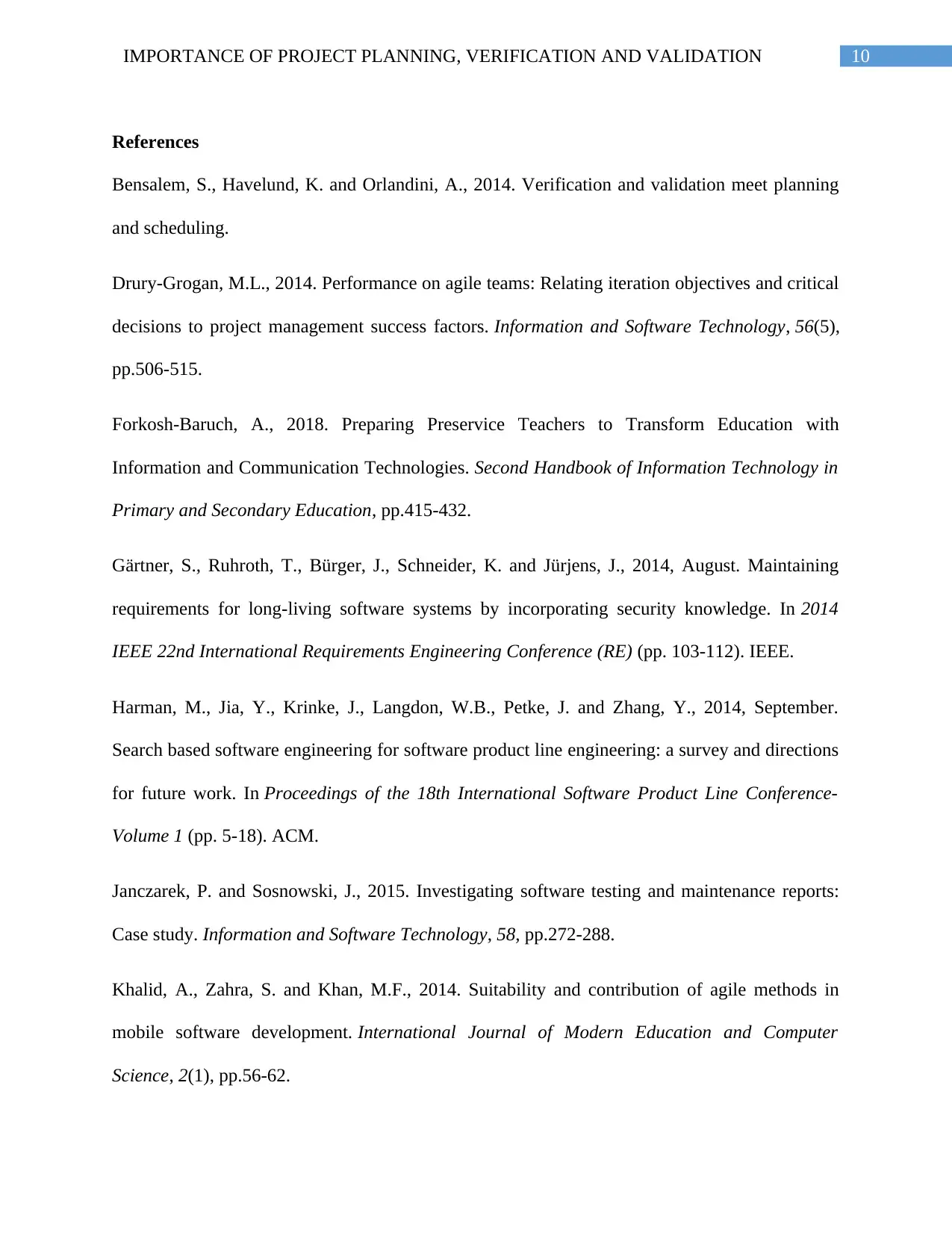
10IMPORTANCE OF PROJECT PLANNING, VERIFICATION AND VALIDATION
References
Bensalem, S., Havelund, K. and Orlandini, A., 2014. Verification and validation meet planning
and scheduling.
Drury-Grogan, M.L., 2014. Performance on agile teams: Relating iteration objectives and critical
decisions to project management success factors. Information and Software Technology, 56(5),
pp.506-515.
Forkosh-Baruch, A., 2018. Preparing Preservice Teachers to Transform Education with
Information and Communication Technologies. Second Handbook of Information Technology in
Primary and Secondary Education, pp.415-432.
Gärtner, S., Ruhroth, T., Bürger, J., Schneider, K. and Jürjens, J., 2014, August. Maintaining
requirements for long-living software systems by incorporating security knowledge. In 2014
IEEE 22nd International Requirements Engineering Conference (RE) (pp. 103-112). IEEE.
Harman, M., Jia, Y., Krinke, J., Langdon, W.B., Petke, J. and Zhang, Y., 2014, September.
Search based software engineering for software product line engineering: a survey and directions
for future work. In Proceedings of the 18th International Software Product Line Conference-
Volume 1 (pp. 5-18). ACM.
Janczarek, P. and Sosnowski, J., 2015. Investigating software testing and maintenance reports:
Case study. Information and Software Technology, 58, pp.272-288.
Khalid, A., Zahra, S. and Khan, M.F., 2014. Suitability and contribution of agile methods in
mobile software development. International Journal of Modern Education and Computer
Science, 2(1), pp.56-62.
References
Bensalem, S., Havelund, K. and Orlandini, A., 2014. Verification and validation meet planning
and scheduling.
Drury-Grogan, M.L., 2014. Performance on agile teams: Relating iteration objectives and critical
decisions to project management success factors. Information and Software Technology, 56(5),
pp.506-515.
Forkosh-Baruch, A., 2018. Preparing Preservice Teachers to Transform Education with
Information and Communication Technologies. Second Handbook of Information Technology in
Primary and Secondary Education, pp.415-432.
Gärtner, S., Ruhroth, T., Bürger, J., Schneider, K. and Jürjens, J., 2014, August. Maintaining
requirements for long-living software systems by incorporating security knowledge. In 2014
IEEE 22nd International Requirements Engineering Conference (RE) (pp. 103-112). IEEE.
Harman, M., Jia, Y., Krinke, J., Langdon, W.B., Petke, J. and Zhang, Y., 2014, September.
Search based software engineering for software product line engineering: a survey and directions
for future work. In Proceedings of the 18th International Software Product Line Conference-
Volume 1 (pp. 5-18). ACM.
Janczarek, P. and Sosnowski, J., 2015. Investigating software testing and maintenance reports:
Case study. Information and Software Technology, 58, pp.272-288.
Khalid, A., Zahra, S. and Khan, M.F., 2014. Suitability and contribution of agile methods in
mobile software development. International Journal of Modern Education and Computer
Science, 2(1), pp.56-62.
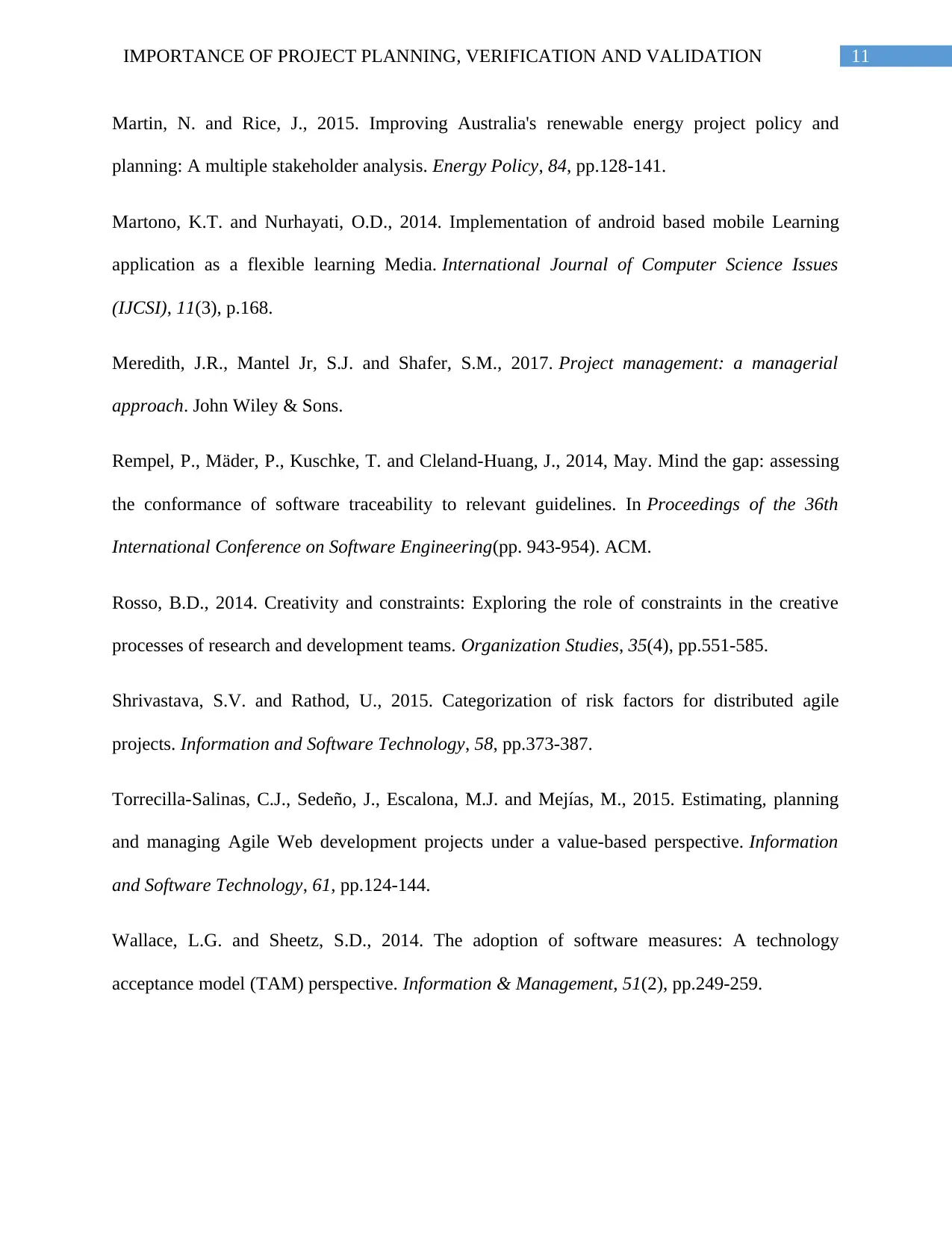
11IMPORTANCE OF PROJECT PLANNING, VERIFICATION AND VALIDATION
Martin, N. and Rice, J., 2015. Improving Australia's renewable energy project policy and
planning: A multiple stakeholder analysis. Energy Policy, 84, pp.128-141.
Martono, K.T. and Nurhayati, O.D., 2014. Implementation of android based mobile Learning
application as a flexible learning Media. International Journal of Computer Science Issues
(IJCSI), 11(3), p.168.
Meredith, J.R., Mantel Jr, S.J. and Shafer, S.M., 2017. Project management: a managerial
approach. John Wiley & Sons.
Rempel, P., Mäder, P., Kuschke, T. and Cleland-Huang, J., 2014, May. Mind the gap: assessing
the conformance of software traceability to relevant guidelines. In Proceedings of the 36th
International Conference on Software Engineering(pp. 943-954). ACM.
Rosso, B.D., 2014. Creativity and constraints: Exploring the role of constraints in the creative
processes of research and development teams. Organization Studies, 35(4), pp.551-585.
Shrivastava, S.V. and Rathod, U., 2015. Categorization of risk factors for distributed agile
projects. Information and Software Technology, 58, pp.373-387.
Torrecilla-Salinas, C.J., Sedeño, J., Escalona, M.J. and Mejías, M., 2015. Estimating, planning
and managing Agile Web development projects under a value-based perspective. Information
and Software Technology, 61, pp.124-144.
Wallace, L.G. and Sheetz, S.D., 2014. The adoption of software measures: A technology
acceptance model (TAM) perspective. Information & Management, 51(2), pp.249-259.
Martin, N. and Rice, J., 2015. Improving Australia's renewable energy project policy and
planning: A multiple stakeholder analysis. Energy Policy, 84, pp.128-141.
Martono, K.T. and Nurhayati, O.D., 2014. Implementation of android based mobile Learning
application as a flexible learning Media. International Journal of Computer Science Issues
(IJCSI), 11(3), p.168.
Meredith, J.R., Mantel Jr, S.J. and Shafer, S.M., 2017. Project management: a managerial
approach. John Wiley & Sons.
Rempel, P., Mäder, P., Kuschke, T. and Cleland-Huang, J., 2014, May. Mind the gap: assessing
the conformance of software traceability to relevant guidelines. In Proceedings of the 36th
International Conference on Software Engineering(pp. 943-954). ACM.
Rosso, B.D., 2014. Creativity and constraints: Exploring the role of constraints in the creative
processes of research and development teams. Organization Studies, 35(4), pp.551-585.
Shrivastava, S.V. and Rathod, U., 2015. Categorization of risk factors for distributed agile
projects. Information and Software Technology, 58, pp.373-387.
Torrecilla-Salinas, C.J., Sedeño, J., Escalona, M.J. and Mejías, M., 2015. Estimating, planning
and managing Agile Web development projects under a value-based perspective. Information
and Software Technology, 61, pp.124-144.
Wallace, L.G. and Sheetz, S.D., 2014. The adoption of software measures: A technology
acceptance model (TAM) perspective. Information & Management, 51(2), pp.249-259.

12IMPORTANCE OF PROJECT PLANNING, VERIFICATION AND VALIDATION
Zhou, Y. and Evans, D., 2014. SSOScan: automated testing of web applications for single sign-
on vulnerabilities. In 23rd {USENIX} Security Symposium ({USENIX} Security 14) (pp. 495-
510).
Zhou, Y. and Evans, D., 2014. SSOScan: automated testing of web applications for single sign-
on vulnerabilities. In 23rd {USENIX} Security Symposium ({USENIX} Security 14) (pp. 495-
510).
1 out of 13
Related Documents
Your All-in-One AI-Powered Toolkit for Academic Success.
+13062052269
info@desklib.com
Available 24*7 on WhatsApp / Email
![[object Object]](/_next/static/media/star-bottom.7253800d.svg)
Unlock your academic potential
© 2024 | Zucol Services PVT LTD | All rights reserved.





